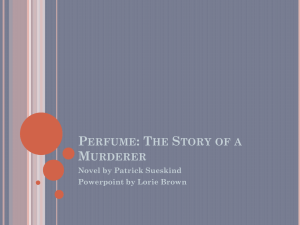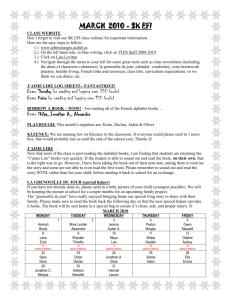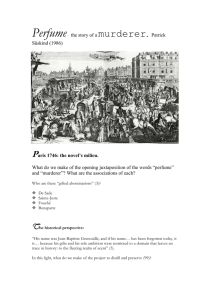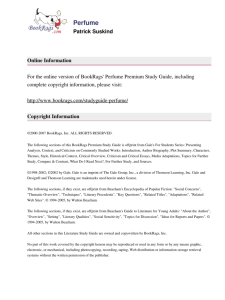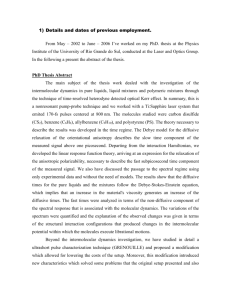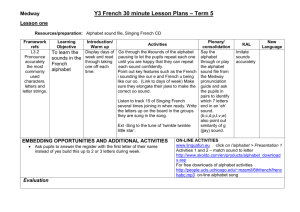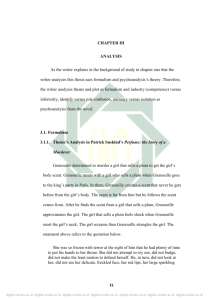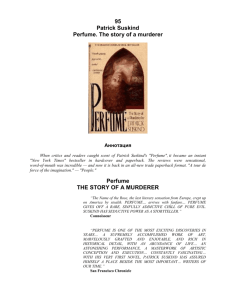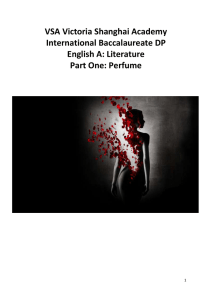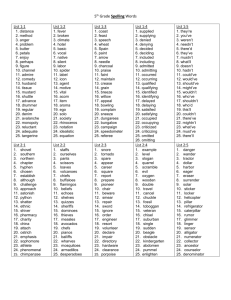Film Essay: “Perfume: The Story of a Murderer”
advertisement
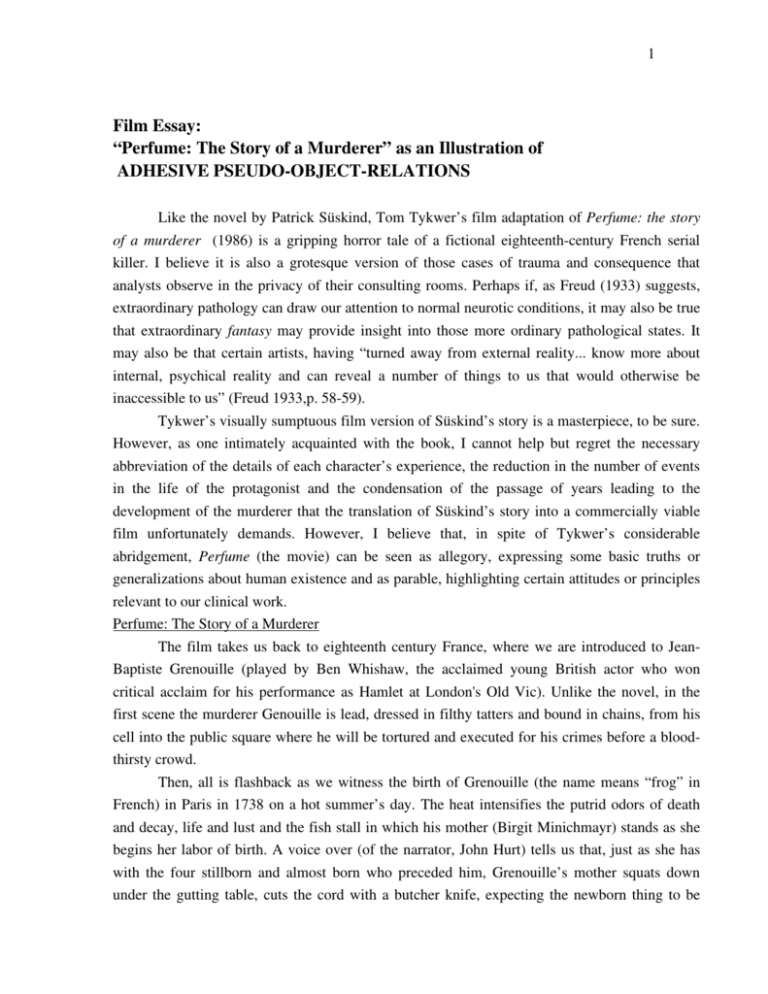
1 Film Essay: “Perfume: The Story of a Murderer” as an Illustration of ADHESIVE PSEUDO-OBJECT-RELATIONS Like the novel by Patrick Süskind, Tom Tykwer’s film adaptation of Perfume: the story of a murderer (1986) is a gripping horror tale of a fictional eighteenth-century French serial killer. I believe it is also a grotesque version of those cases of trauma and consequence that analysts observe in the privacy of their consulting rooms. Perhaps if, as Freud (1933) suggests, extraordinary pathology can draw our attention to normal neurotic conditions, it may also be true that extraordinary fantasy may provide insight into those more ordinary pathological states. It may also be that certain artists, having “turned away from external reality... know more about internal, psychical reality and can reveal a number of things to us that would otherwise be inaccessible to us” (Freud 1933,p. 58-59). Tykwer’s visually sumptuous film version of Süskind’s story is a masterpiece, to be sure. However, as one intimately acquainted with the book, I cannot help but regret the necessary abbreviation of the details of each character’s experience, the reduction in the number of events in the life of the protagonist and the condensation of the passage of years leading to the development of the murderer that the translation of Süskind’s story into a commercially viable film unfortunately demands. However, I believe that, in spite of Tykwer’s considerable abridgement, Perfume (the movie) can be seen as allegory, expressing some basic truths or generalizations about human existence and as parable, highlighting certain attitudes or principles relevant to our clinical work. Perfume: The Story of a Murderer The film takes us back to eighteenth century France, where we are introduced to JeanBaptiste Grenouille (played by Ben Whishaw, the acclaimed young British actor who won critical acclaim for his performance as Hamlet at London's Old Vic). Unlike the novel, in the first scene the murderer Genouille is lead, dressed in filthy tatters and bound in chains, from his cell into the public square where he will be tortured and executed for his crimes before a bloodthirsty crowd. Then, all is flashback as we witness the birth of Grenouille (the name means “frog” in French) in Paris in 1738 on a hot summer’s day. The heat intensifies the putrid odors of death and decay, life and lust and the fish stall in which his mother (Birgit Minichmayr) stands as she begins her labor of birth. A voice over (of the narrator, John Hurt) tells us that, just as she has with the four stillborn and almost born who preceded him, Grenouille’s mother squats down under the gutting table, cuts the cord with a butcher knife, expecting the newborn thing to be 2 shoveled away with the offal and fish heads at the end of the day. However, seemingly stimulated by the odors that surround him, Grenouille’s cry of outrage does not go unnoticed, as have those of his more unfortunate siblings, and he is rescued as his cry betrays his mother’s crime, resulting in her arrest and hanging in the Place de Gréve Grenouille is taken in by Madame Gaillard, (Sian Thomas) a professional foster mother, who boards children for her living. The many other children in her care come to fear Grenouille and attempt to smother him until they finally give up, resorting to avoidance. We are told that Grenouille does not stand until the age of three, nor speak until the age of four. However, when he does speak, he uses only nouns for concrete objects that appear to subdue him. (It may be interesting to note that the word concrete is used in the realm of perfumery to denote ‘a waxy essence of flowers, prepared by extraction and evaporation.’) It is as if Grenouille sees, hears or feels nothing -- he only smells. In fact it is as if he encloses himself in smells -- conjuring up a blissful olfactory experience each time he utters a word -- and this is how he learns to speak. Abstracts remain a mystery to Grenouille. Only things that smell have meaning. We are told that language lacks the refinement for communicating the richness of Grenouille’s olfactory world, and in this instance the imagery of the film excels. We watch as he creates new smells in his mind by combining those already known to him and he seems able to smell these through sheer force of imagination. In this way he appears to effectively shut out the world. In the film, the extent of the trauma that Grenouille endures and the nature of his means of survival is truncated. While, in the novel Süskind makes it quite explicit that, just as he had survived his own birth in a garbage can, while in the custody of Madame Gaillard Grenouille survives measles, dysentery, chicken pox, cholera, a twenty foot fall into a well, and scalding with boiling water, which has been poured over his chest. He has forgone love in favor of survival, and survive he does. He has made his decision “vegetatively, as a bean when once tossed aside must decide if it ought to germinate or had better let things be” (Süskind, 1986, p.25). In the novel, Süskind likens Grenouille’s technique of survival to that of the tick: For which life has nothing better to offer than perpetual hibernation...which by rolling its blue-grey body up into a ball offers the least possible surface to the world; which by making its skin smooth [and] dense, emits nothing ... makes itself extra small and inconspicuous [so] that no one will see it and step on it. The lonely tick,which, wrapped up in itself, huddles in its tree, blind deaf and dumb and simply sniffs...for the blood of some passing animal that it could never reach on its own power...the tick, stubborn, sullen and loathsome, huddles there and lives and waits...for that most improbable of chances...and only then does it abandon caution 3 and drop and scratch and bore and bite into that alien flesh...The young Grenouille was such a tick...encapsulated in himself [he] waited for better times (p.25). Eventually, Madame Gaillard sells Grenouille (now age eight years) to Grimal the tanner (played by Sam Douglas). Grimal exploits children, giving them tasks that none are expected to survive for more than a few years. Having completed the transaction, Madame Gaillard immediately meets a bad end when her throat is slashed by thieves who rob her of her ill-gotten gains. As for Grenouille, from his first whiff of Grimal, the boy senses that his life now depends upon his ability to perform the tasks assigned him in the tannery: scraping meat from the hides, burying and unburying them and hauling water for endless hours. (Here, once again, the film omits some essential details of the trauma endured by Grenouille while growing up in the service of the tanner. Most significantly, he contracts anthrax one year into his indenture to Grimal and barely escapes death. While bearing the scars of his illness, he has become far more valuable, as he is now immune to the deadly disease, which constitutes the primary occupational hazard of a tanner’s assistant. Grenouille now receives more adequate treatment and a modicum of free time. Thus, “the days of his hibernation were over. Grenouille the tick stir[ed] again” (p.38) and he discovers the world of scent inside the city.) Standing on the banks of the river at the Place de Gréve, that place where his mother was hanged in the film, Grenouille catches the odors of the countryside and sometimes of the sea. “He preferred to leave the smell of the sea blended together, preserving it in his memory, relishing it whole” (p.41). He longs to someday arrive to the sea; to merge with its smell. One day, on an outing on behalf of Grimal, a now adolescent Grenouille comes to Faubourg Saint-Germain where the wealthy reside in Paris. It is here that he smells his first perfume. He greedily seeks to possess all the smells, to dissect and to commit them to memory. Then, quite out of the blue, he smells something even more extraordinary. He follows this new scent to discover its source, a beautiful red-haired girl (poignantly acted by Karoline Herfurth). Never has he smelled anything so divine -- more so than all the perfumes of his imagination. However, when he dares to come close to the girl, where she sits in a courtyard pitting plums, she turns suddenly and startles at the sight of him. At that very same moment a passing couple threatens to discover Grenouille. In his effort to subdue the girl’s cries, he accidentally strangles her to death. Desperate to preserve a trace of her scent, he lays the dead girl on the ground, gathering up all the fragrance of her being as he thrusts his face into her hair, over her skin, soaking up her essence in an attempt to seal it away in his innermost compartments. Meanwhile, in the perfumery of Giuseppe Baldini, we watch as the the master himself (played by Dustin Hoffman) struggles to duplicate ‘Amor and Psyche’, the famous perfume of a 4 successful competitor. When Grenouille enters Baldini’s shop to deliver some goatskins on behalf of the tanner (to be infused with perfume for a nobleman), he expresses his desire for a position as an apprentice. At first Baldini laughs, but when he comes to realize what a fine nose Grenouille has, he sets him about the task of recreating that scent which he himself has failed to capture. Once he has accomplished that impossible feat, Grenouille offers the astonished Baldini an even better scent; a scent so heavenly that Baldini is transported to the very gardens of paradise. The next day, Baldini bargains with Grimal for custody of Grenouille and purchases him for a handsome price. As Grenouille settles into his new home in Baldini’s laboratory, we see Grimal, in his celebratory, drunken stupor, falling into the river and drowning, as if in the depths of his own greed. Now, with all the resources of Baldini’s establishment at his disposal, as well as the new skills he acquires under Baldini’s tutelage, Grenouille is free to mix and mate all the various ingredients in the laboratory to create new perfumes for the aggrandizement of his new master’s reputation. For himself, he has hope that he can distill the fragrance of everything within his environment; that he can ‘rob’ all things of their characteristic essence. However, when he fails to realize his dream, he falls mortally ill. Baldini nurses Grenouille back to health, not out of care or human sympathy, but out of greed for those perfume formulae yet to be recorded. Grenouille recovers out of sheer will, fueled by his desire to learn further methods for capturing the scents he has failed to secure through the process of distillation. He eventually satisfies his master’s lust for fame, leaving him the recipe for hundreds of new fragrances in exchange for his journeyman’s papers, so that he might travel to Grasse to learn the art of enfluerage. A freeman at last, Grenouille reaches the city limits of Paris, just as Baldini’s house of perfume, which straddles the Seine at the Pont-au-Change, collapse into the river, presumably killing the ‘great’ and greedy Baldini and submerging Grenouille’s secret formulas in the process. On his way to Orleans, choosing a route through the mountains, one in which he can be surrounded by the simplicity of the countryside. Perhaps for the first time in his life, Grenouille feels nearly delivered from his constant state of olfactory vigilance. He discovers that here, he does not have to prepare himself to catch the scent of something new, unexpected and hostile, or to risk losing a pleasant smell with every breath. He experiences a newfound respiratory freedom in his withdrawal from the compacted human effluvium that had oppressed him within the city limits. He looses his desire to go somewhere, instead trusting his nose to lead him away from humans, to the complete solitude of a cave/tunnel at the peak of the Plomb du Cantal and the bliss of olfactory peace. 5 However, when he finds himself surrounded in a fog-like odor -- his own odor -- that he cannot smell, he awakens with a scream. Leaving his cave and the threat of being suffocated by himself, he attempts to experience his own odor. However not even in his feet or the clothing he had worn in the darkness can he locate his own scent. Upon discovering that the cave/tunnel still smells as if no living being has ever entered it, he leaves the mountain at once and forever, making his way onward to the town of Grasse, the center for the production of perfume. Once there, he tours the town and comes to a stop in front of one home, where he is captured by a familiar scent, one reminiscent of the red-haired girl he has murdered in Paris. He imagines that this new girl’s celestial fragrance is only just beginning to emerge as she emerges into womanhood. The girl is Laure Richis (played by Rachel Hurd-Wood) daughter of the widower Antoine Richis (played by Alan Rickman): the town’s second council and its wealthiest citizen. While awaiting the ripening of Laure’s scent, Grenouille signs on as a journeyman, working in a small perfumery for the widow Arnulfi (Corinna Harfouch). There he practices and excels at the craft of maceration: placing flowers in a caldron of hot oil, which allowed the oil to ‘appropriate’ the scent of the flowers immersed in it prior to cooling and solidifying into a fragrant pomade to be stored in jars. He also learns to make essence absolue from the pomade by separating out the fragrant oil entrapped in the solid. He comes to find that some flowers are too delicate to undergo the process of maceration, and so these are laid out and covered or wrapped with a cool oil-soaked cloth until they exhale their bouquet, which can then be pressed from the cloth as enfluerage. Having perfected a mixture of tallow, lard, suet and oil in order to capture human redolence, Grenouille can now hope to capture and preserve for himself the odor of those rare humans who inspire love. He tests his method first on a prostitute and subsequently on twelve of the most beautiful young virgins of Grasse. The victims are all found naked and shorn of their tresses, having been murdered by a single blow to the back of the head. The people of Grasse are horrified and fearful, until a man is captured and confesses to all of the murders. In spite of evidence that points to the falsity of this confession, the townspeople believe they are now safe, with the exception of Antoine Richis. Like Aurora’s father, Richis guards his ‘sleeping beauty’ with the full extent of his resources. He feels certain that the murderer is not a destructive personality, but rather a careful collector of beauty. He imagines Laure at the center of the murderer’s collection and displays a sense of pride and superiority in having been able to enter into and to analyze the mind of the murderer. Antoine arranges for Laure’s marriage, hoping that, once deflowered, Laure will lose her value for the murderer. As Laure and her father depart Grasse, Grenouille smells Laure’s absence and follows Laure’s scent to the town where Antoine rests for the night on his way to deliver his daughter to 6 her betrothed. Once all are asleep, Grenouille makes his way into Laure’s chamber. Before dawn, his work is complete and Laure is now, for Grenouille, a disembodied scent that he carries away, tucked under his arm, leaving only a lifeless shell for Antoine Richis to find upon awakening. Pursued by a relentless and grief-stricken Richis, Grenouille is discovered, identified and arrested. Ample evidence -- the hair and clothing found buried beneath the floor in his quarters -facilitates Grenouille’s swift conviction. The sentence is one befitting the crime: Grenouille is to be brought to the center of the city square, there to be bound to a wooden cross, henceforth to receive twelve blows with an iron rod, crushing his body, and then to be hung until dead. On the day of his execution, Grenouille is lead out into the public square between the scaffold and the grandstands. Unlike the opening shot of the film, where Grenouille appears in tattered clothing, now we see him dressed in blue velvet finery, representing his own grandiose self-image. As he waves his lace handkerchief, imbued with the scent made up of the essences of the 13 murdered maidens, what the people in the square perceive is not the murderer-Grenouille, but rather innocence personified! All ten thousand men, women, and children fall hopelessly in love with him and are suddenly touched to their erotic core. The result is that the scheduled execution degenerates into the world’s largest orgy. Grenouille has created an aura more radiant and more effective than any human being had ever possessed before him, one that he owes to no one -- not to father, nor to mother, and least of all to a gracious God -- but to himself alone. He is Grenouille the Great! But he cannot enjoy any of it because, although he finally has the love he has so longed for, he cannot find in himself the capacity for love. Grenouille can only feel hatred and contempt. He can only experience gratification in being hated. But there is no such gratification, for even as he hates and wishes to destroy them all, they can do nothing but worship him. Finally, he is embraced by none other than Antoine Richis, who begs forgiveness. But Grenouille only wants to return to Paris to die. As Grenouille enters the gates of the city he comes upon a band of desperados, huddled around a fire near the cemetery. He un-stops the bottle of ‘his’ perfume and douses himself with it. At first the group regards him with awe. But soon this awe turns to rapture and a frenzy of desire in which Grenouille is completely devoured by the crowd. When it is over, the narrator tells us “They were proud. For the first time they had done something out of love.” Discussion of The Story Süskind seems to possess not only an empathically keen and vivid awareness of (and the capacity to be in contact with) some very elemental emotional states, but he also has a rare talent for articulating these in the story of Grenouille. Tykwer’s screen adaptation faithfully preserves the essence of Süskind’s story, which might be viewed as a representation of some significant aspects of mental and emotional life-gone-wrong in the face of extreme environmental tragedy, 7 the likes of which we may never have to bear witness to in our practices as psychoanalysts. However, through the creation of such an extreme tragedy, vastly abbreviated in the film, our attention is drawn to those more subtle and commonly encountered versions that might otherwise escape our mindful observation. In Perfume, odor is a powerful signifier of the infant-Grenouille’s earliest perceptual experiences. The rhinencephalon is the most primitive aspect of the human brain, and it may be that, by describing the era in olfactory terms, the film maker (like the author) draws our attention to that dimension of human experience and existence which is archaic, sensuous, invisible, amorphous and almost totally neglected in the psychoanalytic literature. In the following discussion of the film, I will suggest ways in which Grenouille’s early pre- and post-natal experiences have rendered him extraordinarily vulnerable to subsequent environmental failures, while at the same time providing him with the template for his peculiar method of survival. I will also demonstrate how those cumulative traumas (Khan, 1964), experienced both before and after birth, contribute to the formation and transformation of Grenouille’s second skin (Bick 1968); and finally, I will highlight the various features of ‘adhesive pseudo-objectrelations’ (e.g. the sensation dominated use of objects, the terror of and protections against the awareness of the ‘black hole,’ and the experience of collapse) as they appear in the story of Grenouille. Pre- and Post-Natal History and The Maternal Mental State From the very beginning of the film, we meet Grenouille, an unwanted baby; regarded by his mother even before his birth as dead-meat -- as an object of contempt -- an inconvenience to be discarded and forgotten. Although Grenouille is conceived by his mother, he is never conceived of by her. Mother’s crimes of infanticide are intended to be concealed by the bloody remains of once-living things and the ‘perfume’ of death and decay in the marketplace where she toils alone, uncontained and unsupported by a husbandly-presence. Thus, Grenouille’s first perceptual contact, after his physical birth, is not with a mindful and caring mother’s arms and bosom, but with the smell of death and decay into which he has been premeditatedly dropped by her. Thus, we see how his identity theme is established from the very start of his existence, both within and immediately beyond the womb. Perhaps, in his mother’s phantasies, Grenouille was born to be ‘inconspicuous’ in a world of conspicuous odors. He was as his mother imagined him: odorless. He was born to be evil, the presence of the absence’ incarnate! Having no meaningful presence of his own, perhaps he is equated in her mind with that which is bloody and smelly and intended to cover-up her crime. And indeed he grows up to commit crimes that serve by comparison to dwarf her own. 8 It might be said that Grenouille suffers the ‘privation’ referred to by Winnicott (1963). His conception is totally without illusion1 as is he. There is neither a ‘holding’ (Winnicott, 1960) nor a ‘containing’ (Bion, 1962) object for him to rely upon; no sensory/affective ‘floor’ (Grotstein, 1986) to support him throughout the vicissitudes of infancy. Instead, he is subjected to a barbarically premature and abrupt experience of amputation from his mother: he is literally cut off from and by her with a butcher knife. This nearly unimaginably traumatic ‘weaning’ may have lead to an accentuation of the sensual aspect of his environment; the hyper-activation of and over-reliance upon the sensory modality of olfaction and olfactory sensations, which are then substituted for the nipple-in-themouth as an organizing factor in Grenouille’s life. As if to compensate for the ‘absent object’ (O’Shaughnessy, 1964), Grenouille creates a world-of-scent in which he virtually swaddles himself; perhaps as a protection against the premature awareness of the overwhelming terror and unbearable psychic pain associated with abandonment. I believe that, in this way, Grenouille is able to survive the repeated rejections and severe and multiple traumas and abuses suffered at the hands of his surrogate caretakers. Since a number of these abuses and abusers were deleted from the film version, I will review and discuss only those rejections and the consequences represented chronologically in the film, even though I run the risk that such deletions may dilute the sense of conviction necessary for the reader to seriously consider this authors conclusions. The Trauma of Environmental Failure Bion (1963) reminded us that, in the beginning, “the infant depends on mother to act as its alpha-function” (p.27) and I believe that he vividly conveyed to us the baby’s earliest sensorial experience of the (m)otherly presence in the following passage: The infant, filled with painful lumps of faeces, guilt, fears of impending death, chunks of greed, meanness, and urine, evacuates these bad objects into the breast that is not there. As it does so, the good object turns the no-breast (mouth) into a breast, the faeces and urine into milk, the fear of impending death and anxiety into vitality and confidence, the greed and meanness into feelings of love and generosity and the infant sucks its bad property, now translated into goodness, back again (p. 31). 1 In a discussion of the ‘value of illusion’, Winnicott (1951) explained that “the mother, at the beginning, by an almost 100 percent adaptation, affords the infant the opportunity for the illusion that her breast is part of the infant ... under [his or her] magical control” (p.238) and also “that there is an external reality that corresponds to the infant’s own capacity to create ... psychologically, the infant takes from a breast that is part of the infant, and the mother gives milk to an infant that is part of herself ... the idea of interchange is based on an illusion” (p.239). It seems that without illusion, there can be no development of relationship in the true sense of the word. 9 Grenouille finds no such succor in the custody of the foster mother, Madame Galliard. Although he is given physical care, this care is stripped of all human passion and thoughtful contemplation. He became a ‘tick’, shelling himself off from human relatedness in favor of invulnerability in what appears to be a state of perpetual ‘affective’ hibernation. He emits nothing and is impenetrable (a state, it seems, in which it may be assumed that normal introjective or projective processes fail to take hold and develop). Eventually, Grenouille is doomed to rejection once again. In the hands of Grimal, the tanner who exploits children cruelly, little Grenouille suffers a psychosomatic explosion from which he is able to emerge, all the more immunized against death. Here we find that he has developed a new physical manifestation of his ‘second skin’: the scars covering his body, permanently left in the wake of his struggle with anthrax. Afterward, Grenouille engages in a limited sensual (olfactory) exchange with his environment and one day, while standing in the place of his mother’s execution, he experiences (in olfactory terms) the longing for merger with the idealized womb-mother, represented by the sea in Süskind’s story (again, described in olfactory terms). Grenouille’s first encounter with ‘perfume’ (that seems to represent the essence of goodness and innocence in this tale) occurs during these same days. This ‘goodness’ is soon to be equated with the smell of a virginal-girl who is pure and innocent and who has ‘known’ no one. There is a strong implication here that ‘perfume’ is equated with the idealized-maternalobject/innocent-baby-Grenouille in an undifferentiated and unintruded-upon state. Grenouille soon discovers that only through death can he preserve this scent for himself. Perhaps experience has taught him that objects must be frozen, deadened or somehow immobilized in order to keep them from exerting their own will and eventually and inevitably abandoning him. Perhaps his attempts to freeze his objects in time correspond with the timelessness of Grenouille’s two-dimensional existence and stunted development. However, in this first attempt to preserve that sense of at-one-ment with the ‘good-mother,’ he learns that he can only take on the ‘essence’ of the object through skin-to-skin contact, but that he cannot hope to take it in and therefore to make it his own. Perhaps, for the first time, Grenouille experiences the bliss of ‘atone-ment’ and discovers a new raison d’etre; the creation of beautiful scents ( i.e. the ‘essence’ of the idealized birth-mother.) Formation and Transformations of Grenouille’s Second Skin Grenouille grows up not unlike some autistic children. He does not stand until the age of three; he does not utter a word until the age of four; and when he does begin to speak, his utterances are restricted to nouns (‘things’) while pronouns, indicating acting and receiving agents, are absent in his speech. He seems to use words solely for their sensuous affect upon him. 10 It might be understood that these words create auto-sensuous ‘shapes’2 (Tustin, 1984) upon Grenouille’s lips and tongue, providing him with sensations that serve to calm and subdue him. For Grenouille, only the sensuous matters. It may be that these essential smells are the sensuous derivatives of the ‘activation contours’3 of Grenouille's affective experiences (Stern, 1985); more rich in meaning than language. Although Grenouille appears to be feebleminded from the vertex of the outside observer -- presumably an objective vertex -- in Grenouille’s experience (which is thoroughly walled off from detection) his mind is one of ‘riches and imagination’ that, although idiosyncratic, unshared and defensively motivated, is rich nonetheless. Although this might be put forward as evidence that indeed Grenouille had ‘secretly’ developed some mental life -- an intellect and an ‘internal world of objects’ in the Kleinian sense -- I would suggest that what appears to be a true mentality is actually that which is described by Winnicott as a ‘pathological-mind-psyche’, developed to take over the function of the missing environ-mental mother. Twice, both in the service of Grimal the tanner and later in the service of Baldini the perfumer, Grenouille experiences a psychosomatic explosion that is associated in the story with extremes of physical abuse and psychic dissolutionment. Each time Grenouille manages his own reconstitution through the development of an ever-tougher ‘second skin’ (concretely represented by the scars and ugliness which shield and protect him from painful and even deadly contact) as well as a growing sense of grandiose omnipotence. This grandiosity is represented in the relationship with Baldini, in scenes where he magically reproduces and then invents scents surpassing those of his master’s imagination. Only when Grenouille fails to capture the scent of inanimate things, does he fall ill once again. Perhaps it might be understood that these experiences of trauma and disillusionment that remain untransformed by tender and caring interactions with a maternal-object, inhabit and are expressed in the somatic symptom (Mitrani, 1993). As Bion (1962) suggests, uncontained sensory experiences exist as concrete accretions of stimuli that are neither used to create meaning 2 Autistic shapes (1984) are distinguished from objective shapes (such as a square or circle), in that they are idiosyncratic, endogenous swirls of sensation produced upon the surface of the skin or internally with the aid of bodily substances or objects which have a numbing or tranquilizing effect upon the individual which blocks out painful and terrifying awareness. 3 An activation contour (Stern, 1985) is an engramatic pattern which is registered at the somatic or physiological level -- the level of brain, not at the level of mind. According to Stern, each activation contour is composed of a set of vitality affects: formations of feelings or somato-sensory experiences, i.e. waves or rushes of feeling, perhaps laid down as a pattern of neural firing in a particular area of the nervous system. Unlike categorical affects (e.g. sadness, happiness, anger) have no symbolic content. Abstract dance and music are examples par excellence of the expressiveness of vitality affects, which do not resort to plot or categorical affect signals. 11 nor stored as memories in the mind. They are neither remembered nor forgotten, but are instead held in abeyance in the somatic realm, exploding under pressure of life’s inevitable stressors. It could also be said that these unmetabolized sensations (beta-elements) are organized in somatic dis-ease, and may then constitute a ‘Beta-screen’ which functions as a ‘second skin’, providing the essential protective boundary for the self -- even a ‘false-self’ or ‘as-if personality’ -- within which one might survive and function. And so, even as he is exploited, Grenouille is able to achieve something resembling a life. He seems, at last, to attain some reprieve from the bondage that has been substituted for the missing experience of bonding (Grotstein, 1989). When he leaves Baldini, for some time he retreats into complete isolation atop the Plomb du Cantal in a never-before-inhabited cavern, which may offer him a womb-like environment and the prospect of ‘olfactory peace’. Perhaps within this cave inside the remains of a once-active volcano, it might be said that Grenouille recoups the primal experience: that pre-birth experience of ‘being the only human being in the world’ of the maternal body. Symbols of fetal existence abound here (in the novel if not in the film) from the ‘virgin’ tunnel in which he curls up, to the umbilical-snakes that nourish him and the uterine wall (the rocks) that he licks in quite a sensual manner to obtain lifesustaining moisture. Within ‘his empire’ Grenouille engages in a sort of ‘olfactory myercism’, regurgitating the smells of his past ‘within his innermost universal theater,’ ostensibly as an essential means of protecting himself from the terrifying awareness of his otherwise ‘softfleshed’ vulnerability. Gaddini’s (1969) concept of the ‘psycho-oral’ may allow some understanding to emerge from this description of Grenouille’s accentuated sense of smell. Gaddini (1959) explores the phenomenon of myercism in very young infants who have undergone serious oral frustrations soon after birth. He observes that these very early frustrations, when coupled with a traumatic weaning, lead to difficulties in introjective identification. Later, (1969) developing the concept of the ‘psycho-oral’, Gaddini proposes that “all sense organs may unconsciously be perceived as mouth-like” (p.478n), an idea in keeping with Stern’s later conceptualization of ‘amodal perception’4. Gaddini suggests that there might be an excessive intensification of other modalities of sensory stimulation that compensate for and are due to insufficient oral stimulation. 4 According to Stern (1985) newborns have an innate capacity to take information received in one sensory modality and to translate it into any other sensory modality. The resultant perception exists in some ‘supra-modal’ form (e.g. wherein the breast that is seen, the breast that is smelled, the breast that is tasted, and the breast that is touched are linked together) and is encoded in what Stern refers to as an amodal representation which can be recognized in any of its sensory modalities. 12 Finally, a dream penetrates Grenouille’s mindlessness, creating a fog that threatened to suffocate him. Perhaps this fog, like the ‘fog’ described by Meltzer (1975) as the muddled up feeling of ‘disintegration’ or the experience of falling-apart, is felt to pose a threat to Grenouille’s continuity-of-being, described in this passage from the novel. He was deathly afraid, his whole body shook with a raw fear of death ... he sat there shivering and trying to gather his confused, terrified thoughts, he knew one thing for sure: he would change his life, if only because he did not want to dream such a frightening dream a second time. He would not survive it a second time (Süskind, 1986, p.164). He escapes this state, seeking human contact once again. He is overtaken by a new obsession: to create and possess a ‘superhuman scent’ in order that he might inspire love. Grenouille goes about his task, collecting each of the components of this ‘super-smell’ from the remains of the virginal beauties he murders. In the film, Tykwer (as Süskind does in the novel) uses the character Antoine Richis to provide the necessary insight for an understanding of Grenouille’s motivation. Richis believes that the murderer’s aim is not to destroy but to collect, and as such, his is not an attack on beauty, but an effort to preserve beauty for himself. Like those autistic children who conceptualize growth as occurring in ‘bits’ acquired from the object and stuck onto the self (Tustin, 1981), Grenouille seems to conceive of the development of a loveable-he through acquisition and adhesion. Indeed, after he is captured and convicted for his murderous crimes, Grenouille appears as-if reborn:‘innocence personified’ in his self-made ‘skin’ of scent. But his triumph is empty! As always, he cannot find reciprocity for his emotional states. Just as his overflowing love and his craving for attachment have been met in the past with hatred, so now his overwhelming hatred begets only love. He cannot find resonance in others for what he has walled-off within himself. Once again Grenouille is overcome by the ‘fog of his odorlessness’, which might be understood as an awareness of an experience of ‘no-body-ness’ and the feeling of unintegration. Grenouille is filled with a boundless (uncontained) terror that constitutes the final and devastating realization of the concordance between his internal and external realities. Although Grenouille is embraced by Antoine Richis, it soon becomes apparent that it is not he who is loved, but the reflection of Richis’ own omnipotent projections, evoked by the effects upon him of Grenouille’s odoriferous ‘second skin’. In the end, Grenouille grows increasingly maddened by an uncaring world. He appears overcome by a despair evoked by the painful realization that he might never be seen and loved for himself; that he might never become himself. Once again he seeks an experience of being 13 ‘one’ with the body of the mother. Toward this end, he provokes the band of desperados to cannibalism and is finally ‘taken in’ -- eaten -- in an act of ‘love’. Indeed, this is the ultimate act of love, for it seems that what Süskind described in the novel, and what Tykwer creates on the screen in such concrete terms is the baby’s experience of being introjected by the maternal object; an experience which the baby must have in order for him to be able to incorporate a sense of a containing object. The infant’s identification with such an object is absolutely necessary to the development of the all-important functions of introjection and projection. Perfume as an illustration of Adhesive Pseudo-Object-Relations Although it might be said that Grenouille lacks the capacity for object relations in the ordinary sense of the term, his behavior and experience seem to fit the description of adhesive pseudo-object-relations (Mitrani 1994). Grenouille uses his objects in much the same way that the autistic child uses objects: for the sensations that they engender upon the surfaces and mucous membranes of his body -- sensations that provide a sense of impermeability, grandiosity, security or tranquility. Whether Grenouille manipulates or avoids his objects depends largely upon his ‘sense’ of these as either protectively comforting or threateningly impinging. His repeated experience of the unreliability of his objects leads him to rely upon those olfactorysensation/objects (perfumes) that he can create for and by himself. At first Grenouille’s idyllic existence inside the cave at Plomb du Cantal seems to re-create an illusion of those earliest experiences of at-one-ment within the body of the mother. Only after some time, hidden away in his claustrum of stone, does the awareness of ‘the black hole’ experience intrude into and dissolve Grenouille’s illusion; an experience of the awesome force of powerlessness, of defect, of nothingness, of ‘zero-ness’ -- expressed, not just as a static emptiness but as an implosive, centripetal pull into the void. I believe it is from this momentary awareness of the aridity and bottomlessness of that ‘black hole’ within, as it appears to him in the dream, that Grenouille flees in terror. He has moved from a state of mindless oblivion in the cave to a state of near-total collapse and, in a reflexo-physiological way, he moves toward human contact; a move from avoidance of affective contact toward further sensation-dominated manipulation of humankind. Grenouille’s self-generated olfactory re-productions provide him with a sensual delusion of safety. Throughout the film we can see how the failure of Grenouille’s omnipotence is invariably followed by near physiological collapse and the subsequent reconstitution of an even more impenetrable ‘second skin’. The development of Grenouille’s ‘second skin’ can be traced from his earliest ‘tick-like’ (muscular) encapsulation, through utilization of odoriferous sensations as a protective sheath, to a survival-oriented hyper-activity. The scars he acquires in his battle with anthrax serve to toughen him even further against those cruel contacts with human beings, just as his everincreasing ugliness serves to ward off the threat of painful human closeness. This tough exterior 14 secures for Grenouille an internal chamber in which he can ‘hide’ away and seal-off from threat of loss those precious stolen scents of the ‘madonna-esque’ as well as the vital ‘essence’ of his own authentic self; that never-loved and therefore unborn-he. Grenouille’s experience of suffocation seems to be a side effect of this protective sealingoff of all that is ‘good’ and alive in himself and his panic, a result of the fleeting awareness that he cannot access -- cannot smell -- this aspect of his own nascent ‘self’. Neither can he avail himself of the good-objects he has sealed-off inside. The fortress that he has erected in avoidance of the ‘black hole’ experience that threatens him becomes a penitentiary from which he cannot escape into life. The theme of collapse permeates Süskind’s story and Tykwer’s film, always coinciding with extremes of privation, disillusionment, separation and loss. It would appear that in art, as in life, those experiences that remain untransformed and unmitigated in the mind are sometimes dealt with by assignment to and expression in the actions of others. For example, all of Grenouille’s caretakers perish in the wake of his departure. If one can imagine that each has been experienced by Grenouille, not as a separate individual but as a bodily part, then the death of each one takes on additional significance as a concrete expression of Grenouille’s own recurrent experience of mutilation and psychic death. For example, just as Grenouille’s mother’s neck was broken in hanging, his own psyche was terminally dissociated from his physical being; just as Galliard was robbed and murdered, so Grenouille was robbed of illusion by extremes of hypocrisy and disregard; just as Grimal was drowned in a state of self-induced stupor, Grenouille was submerged in the blocking out of his own awareness; just as Baldini’s whole world suddenly and inexplicably imploded and collapsed, so Grenouille had felt the collapse of the maternal environment and of the protective ‘shell’ that he had created as a substitute for it; and finally, just as the Antoine Richis became confused between goodness and evil, so was Grenouille perverted in his relationship to these same polar opposites. Last but not least are the deaths of all those beautiful innocents. Just as they had been rendered unconscious, their hair shorn, stripped of their clothing and robbed of the very ‘essence’ of their being, Grenouille had been robbed of his own ‘essence’; his innocence, long ago sacrificed for the sake of bodily survival. All these deaths, I believe, might be seen to represent those ‘felt’ and deflected sensory experiences of an abandoned and dying baby-Grenouille. Concluding Thoughts Hamilton (1989) reserves the word trauma “for responses to events which arouse in most of us intense feelings of horror, a sense of outrage and very often a feeling of revulsion and turning away. We would rather not know and hear”(p.74). As therapists we might often rather ‘turn away’ in order to insulate ourselves from such trauma, as have our patients who suffered the 15 insult of catastrophic events at those moments in time -- in earliest infancy or even before birth -when they were ill-prepared to do otherwise. The story of Grenouille conveys the quintessence of trauma; it is perhaps an extreme caricature of others we have ‘known’ and ‘heard’ in our consulting rooms. As psychoanalysts, we strive to be open and receptive in our attitude towards our patients in order to experience, understand and interpret mutatively; perhaps even in order to imagine our patients anew, as separate and apart from the theories within which we may find ourselves safely swaddled. We aspire to be able to tolerate, to accept and initially to affirm experiences as they are re-lived in the transference; this toward a modification of experience in the long run. However we must always be aware of our own as well as our patients’ limitations -- the threshold of our own intolerance of the horrific, the outrageous and the revolting -- especially our own tendency to turn away from or perhaps to ‘abjectify’, to hurl away or to cut-off our patients’ communications prematurely when these threaten to debride our old wounds, long ago scared over and forgotten. Perhaps adhesive identity or adhesive equation can only be relinquished by the patient as the analyst dares to relinquish his or her own insulation against the awareness of unhealed personal wounds, which may constitute a ‘black hole’; this, in order to allow some momentary mingling of experiences, out of which true object relatedness may evolve. 16 References Bick, E. (1968). The experience of the skin in early object-relations. Int. J. Psychoanal., 49: 484-486. _______. (1986). Further considerations on the function of the skin in early object relations. Brit. J. Psychother., 2 (4). Bion, W.R. (1962). Learning from experience. In Seven Servants. New York: Jason Aronson. ________. (1963). Elements in psychoanalysis. In Seven Servants. New York: Jason Aronson. Freud, S. (1906). Delusions and dreams in Jensen’s Gradiva. S.E. 9: 7-94. ______. (1933). New introductory lectures on psychoanalysis. S.E. 22:87-111. Gaddinni, E. (1969). On Imitation. Int. J. of Psycho-anal. 50(4): 475-84. __________. (1959). Rumination in infancy. In Dynamic Psychology in Childhood , p.166-185, ed. L. Jessner and E. Pavensteat. London: Grune and Stratton. Grotstein, J. (1989). Of human bondage and of human bonding: the role of friendship in intimacy. Contemporary Psychotherapy Review. 5 (1):5-32 ________. (1990). Nothingness, meaninglessness, chaos, and the “black hole”* II. Contemp. Psychoanal. (26)3:377-407. Hamilton, V. (1989). The mantle of safety. Winnicott Studies. 4:70-95. Khan, M. (1964). Ego distortion, cumulative trauma and the role of reconstruction in the analytic situation. Int. J. Psycho-anal. 45: Klein, M. (1932). The Psychoanalysis of Children. New York: Dell. _______. (1955). On identification. In Envy and Gratitude and Other Works. New York: Dell Publishing. Meltzer, D. (1975a). Adhesive identification. Contemp. Psychoanal. 11(3). _________, Bremner, J., Hoxter, S., Weddell, D., and Wittenberg, I. (1975b). Explorations in Autism. Perthshire: Clunie. Mitrani, J. (1993). ‘Unmentalized’ experience in the etiology and treatment of psychosomatic asthma. Contemp. Psychoanal, 29 (2): 314-342. _________. (1994). On adhesive-pseudo-object Psychoanalysis, 30 (2):348-366. relations: theory. Contemporary 17 O’Shaughnessy, E. (1964). The absent object. J. Child Psychother., 1(2): 34. Stern, D.L. (1985). The interpersonal world of the infant. New York: Basic Books. Süskind, P. (1986). Perfume: the Story of a Murderer. New York: Alfred Knopf, Inc. & Pocket Books. Tustin, F. (1969). Autistic processes. J. Child Psychother., 2(3), 23. ________. (1972). Autism and childhood psychosis. London: Hogarth. _______. (1981). Autistic states in children. London: Routledge & Kegan Paul. _______. (1983). Thoughts on autism with special reference to a paper by Melanie Klein. J. Child Psychother., 9:119. _______. (1984). Autistic shapes. Int. Rev. Psychoanal. 11 (3), 279-290. _______.(1984). The growth of understanding. J. Child Psychother., 10 (2), 137. _______.(1986). Autistic barriers in neurotic adults. London: Karnac Books, Ltd. ________(1990). The Protective Shell in Children and Adults. London: Karnac. Winnicott, D.W. (1949). Mind and its relation to the psyche-soma. In Collected Papers: Through Pediatrics to Psycho-analysis. New York: Basic Books. 1958. _________.(1951).Transitional objects and transitional phenomena. In Collected Papers: Through Pediatrics to Psycho-analysis. New York: Basic Books. 1958. _________ (1958). The capacity to be alone. In The Maturational Process and the Facilitating Environment. New York: IUP. 1965. _________ (1960). The theory of the infant-parent relationship. Int. J. Psychoanal., 41: 585-595. _________ (1962). Ego integration in child development. In Maturational Processes and the Facilitating Environment. New York: IUP. 1965. Judith L. Mitrani, Ph.D. 2050 Fairburn Avenue Los Angeles, CA 90025 December 2006
